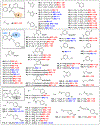Exploration of the Structural Space in 4(3 H)-Quinazolinone Antibacterials
- PMID: 32343145
- PMCID: PMC7720656
- DOI: 10.1021/acs.jmedchem.0c00153
Exploration of the Structural Space in 4(3 H)-Quinazolinone Antibacterials
Abstract
We report herein the syntheses of 79 derivatives of the 4(3H)-quinazolinones and their structure-activity relationship (SAR) against methicillin-resistant Staphylococcus aureus (MRSA). Twenty one analogs were further evaluated in in vitro assays. Subsequent investigation of the pharmacokinetic properties singled out compound 73 ((E)-3-(5-carboxy-2-fluorophenyl)-2-(4-cyanostyryl)quinazolin-4(3H)-one) for further study. The compound synergized with piperacillin-tazobactam (TZP) both in vitro and in vivo in a clinically relevant mouse model of MRSA infection. The TZP combination lacks activity against MRSA, yet it synergized with compound 73 to kill MRSA in a bactericidal manner. The synergy is rationalized by the ability of the quinazolinones to bind to the allosteric site of penicillin-binding protein (PBP)2a, resulting in opening of the active site, whereby the β-lactam antibiotic now is enabled to bind to the active site in its mechanism of action. The combination effectively treats MRSA infection, for which many antibiotics (including TZP) have faced clinical obsolescence.
Conflict of interest statement
The authors declare the following competing financial interest(s): US patent 9,776,975 has been issued for the quinazolinones.
Figures




Similar articles
-
The Quinazolinone Allosteric Inhibitor of PBP 2a Synergizes with Piperacillin and Tazobactam against Methicillin-Resistant Staphylococcus aureus.Antimicrob Agents Chemother. 2019 Apr 25;63(5):e02637-18. doi: 10.1128/AAC.02637-18. Print 2019 May. Antimicrob Agents Chemother. 2019. PMID: 30858202 Free PMC article.
-
Structure-Activity Relationship for the 4(3H)-Quinazolinone Antibacterials.J Med Chem. 2016 May 26;59(10):5011-21. doi: 10.1021/acs.jmedchem.6b00372. Epub 2016 May 5. J Med Chem. 2016. PMID: 27088777 Free PMC article.
-
Discovery of antibiotic (E)-3-(3-carboxyphenyl)-2-(4-cyanostyryl)quinazolin-4(3H)-one.J Am Chem Soc. 2015 Feb 11;137(5):1738-41. doi: 10.1021/jacs.5b00056. Epub 2015 Feb 2. J Am Chem Soc. 2015. PMID: 25629446 Free PMC article.
-
4(3H)-Quinazolinone derivatives: Promising antibacterial drug leads.Eur J Med Chem. 2019 May 15;170:157-172. doi: 10.1016/j.ejmech.2019.03.018. Epub 2019 Mar 11. Eur J Med Chem. 2019. PMID: 30884322 Review.
-
A Review on Five and Six-Membered Heterocyclic Compounds Targeting the Penicillin-Binding Protein 2 (PBP2A) of Methicillin-Resistant Staphylococcus aureus (MRSA).Molecules. 2023 Oct 10;28(20):7008. doi: 10.3390/molecules28207008. Molecules. 2023. PMID: 37894491 Free PMC article. Review.
Cited by
-
Synergistic effect of new pyrimidine derivative with oxacilin against methicillin-resistant Staphylococcus aureus.Future Med Chem. 2024;16(18):1839-1852. doi: 10.1080/17568919.2024.2385887. Epub 2024 Sep 5. Future Med Chem. 2024. PMID: 39235081 Free PMC article.
-
Critical view on antimicrobial, antibiofilm and cytotoxic activities of quinazolin-4(3H)-one derived schiff bases and their Cu(II) complexes.Heliyon. 2024 Apr 2;10(7):e29051. doi: 10.1016/j.heliyon.2024.e29051. eCollection 2024 Apr 15. Heliyon. 2024. PMID: 38601653 Free PMC article.
-
Novel Thiazolylketenyl Quinazolinones as Potential Anti-MRSA Agents and Allosteric Modulator for PBP2a.Molecules. 2023 May 22;28(10):4240. doi: 10.3390/molecules28104240. Molecules. 2023. PMID: 37241983 Free PMC article.
-
β-Lactams against the Fortress of the Gram-Positive Staphylococcus aureus Bacterium.Chem Rev. 2021 Mar 24;121(6):3412-3463. doi: 10.1021/acs.chemrev.0c01010. Epub 2020 Dec 29. Chem Rev. 2021. PMID: 33373523 Free PMC article. Review.
-
Unconventional Antibacterials and Adjuvants.Acc Chem Res. 2021 Feb 16;54(4):917-929. doi: 10.1021/acs.accounts.0c00776. Epub 2021 Jan 29. Acc Chem Res. 2021. PMID: 33512995 Free PMC article.
References
-
- Centers for Disease Control and Prevention. Antibiotic Resistance Threats in the United States, 2019. Atlanta, GA: U.S. Department of Health and Human Services, Centers for Disease Control and Prevention, 2019, 1–50.
-
- Pourmand A; Mazer-Amirshahi M; Jasani G; May L Emerging Trends in Antibiotic Resistance: Implications for Emergency Medicine. Am. J. Emerg. Med 2017, 35, 1172–1176. - PubMed
-
- Hofer U The Cost of Antimicrobial Resistance. Nat. Rev. Microbiol 2019, 17, 3. - PubMed
-
- Rice LB Federal Funding for the Study of Antimicrobial Resistance in Nosocomial Pathogens: No ESKAPE. J. Infect. Dis 2008, 197, 1079–1081. - PubMed
-
- Bush K Synergistic Antibiotic Combinations. Top. Med. Chem 2018, 25, 69–88.
Publication types
MeSH terms
Substances
Grants and funding
LinkOut - more resources
Full Text Sources
Medical
Molecular Biology Databases
Research Materials
Miscellaneous

